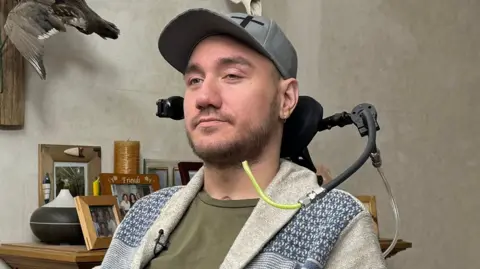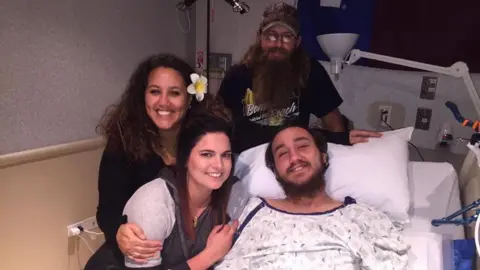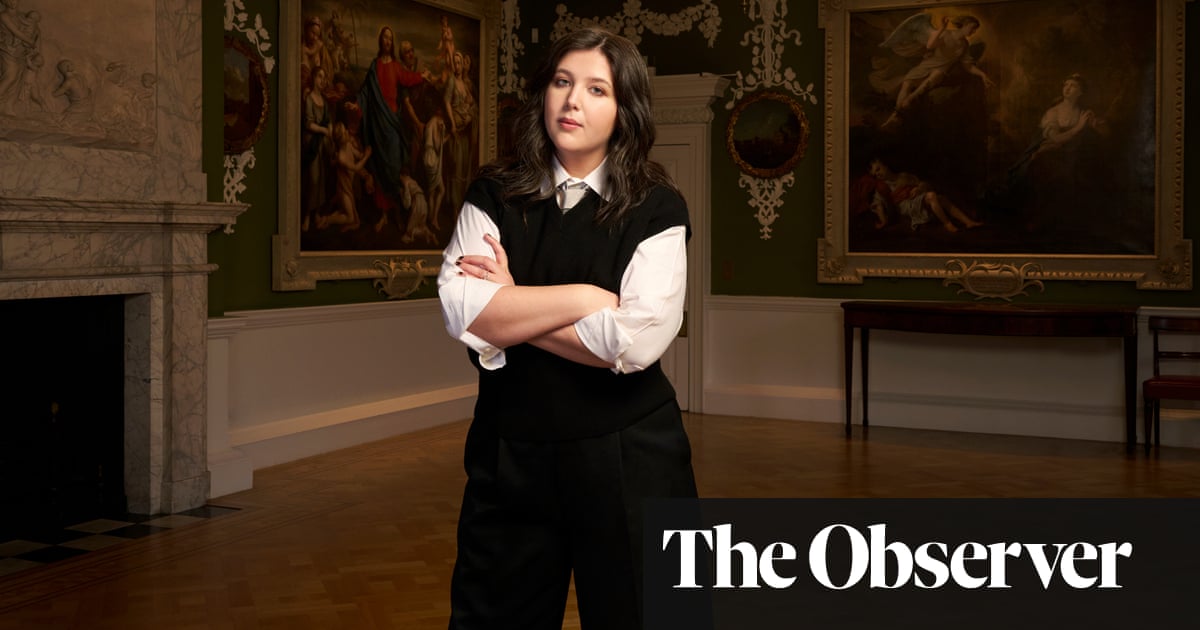Thanks to Elon Musk, the man with a mind -reading chip in his brain

BBC News
 BBC
BBCHaving a chip that can turn your thoughts into computer commands in your brain may seem like science fiction – but this is a fact for Noland Arbaugh.
In January 2024 – eight years after being paralyzed – 30 -year -old US neurotechnology company Nealink’ten was the first person to receive such a device.
This was not the first chip – a handful of other companies developed and implanted them – but it inevitably draws more attention because of Elon Musk, the founder of Noland’s Nevralink.
But Noland says that the important thing is neither Him nor musk – but science.
He told the BBC that he knew the risks of what he did – but “Good or bad, I would help, no matter what”.
“If everything goes well, then I could help Neuralink a participant,” he said.
“If something terrible, I knew they’d learn from him.”
‘No control, no privacy’
Noland from Arizona was paralyzed under the shoulders in a diving accident in 2016.
Their injuries were so violent that he could not work again, could not work or even play games.
“You just don’t have control, you don’t have privacy, and it’s hard,” he said.
“You have to find out that you need to trust other people for everything.”
The neuralink chip is trying to restore some of his previous independence by allowing him to control a computer with his mind.
It is known as the brain computer interface (BCI), which works by detecting small electrical impulses produced while people consider moving and turning them into a digital command like moving them on a screen.
It is a complex issue that scientists have been working on for decades.
Inevitably, Elon Musk’s participation in the field launched technology – and Noland Arbaugh into headlines.
It helped Neuralk to get too much investment – also examining the safety and importance of an extremely invasive procedure.
When Noland implant is announced, Experts greeted this as “an important milestone”Particularly considering the adequacy of Musk’s “creation for the company”, he is warned that the evaluation will take time.
Musk was open to the public at the time, just in a social media post: “The first results showing promising neuron pointed determination.”
In fact, Noland said that the billionaire he spoke before and after his surgery was much more optimistic.
“I think he was excited to start,” he said.
However, he emphasizes that Neuralink is more than the owner and claims that he did not see it as a “Elon Musk device”.
Whether the rest of the world saw this in this way – Particularly considering the more and more controversial role in the US government – It is seen.
However, there is no question to question the impact of Noland’s life.
‘This should not be possible’

When Noland woke up from the surgery, Noland said, at the beginning, he could control a cursor on the screen, considering moving his fingers.
“I didn’t know what to expect to be honest – it sounds very sci -fi.”
However, after seeing the increase of neurons on a screen – always surrounded by exciting neuralink employees – he said, “everything was dipped,” he said, “everything was sinking.”
And – even better – the ability to use implant over time has grew up to the point where he could play chess and video games.
Im I grew up playing games, dedi he said – it was something he had to leave when it was disabled.
“Now I’m beating my friends in the games, that’s not really possible, but it’s.”
Noland is a strong demonstration of technology’s potential to change the lives – but there may be disadvantages.
“One of the main problems is confidentiality,” he said.
“So if we export our brain activity […] Then we allow it not only to do it, but also what we think potentially, what we believe and what we feel. “
“When you have access to things in your head, there is no other obstacle for personal privacy to remain.”
But these are not concerns about Noland – he wants to see that the chips are going further in terms of what they can do.
He told the BBC that he could allow him to control his wheelchair, even a futuristic humanoid robot at the end of the device.
Even if the existing, more limited technology was not a smooth sail.
At one point, a problem with the device caused his computer to completely lose control when he was partially broken from his brain.
He said, “At least it was really sad to say.”
“I didn’t know if I could use Nevralink again.”
The connection was repaired when the engineers set the software and were developed later, but emphasized a frequently expressed concern by experts on the limitations of technology.
Big business
Neuralink is just one of the many companies that investigate how to digitally touched our brain power.
Synchron is such a company that says that the stentrot device, which aims to help people with motor neuron disease, requires less invasive surgery for implant.
Instead of asking for open brain surgery, a person’s neck is placed in the jugular vessel, then moves from a blood vessel to his brain.
Like neuralink, the device is ultimately connected to the engine area of the brain.
“Someone gets when someone thinks of touching or touching his finger.” He said.
“By taking these differences, it can create what we call digital engine output.”
This output is then converted to computer signals that are currently used by 10 people.
Such a person who does not want the use of his surname, BBC, the device is the first person to use Apple Vision Pro ear set, he said.
Mark said that it allows it to almost holiday in almost far away places, from standing in the waterfalls in Australia to wandering in the mountains in New Zealand.
“In the future, I can see a world in which this technology can really make a difference for this or any paralysis,” he said.
However, there is a warning with the neuralink chip for Noland – he agreed to be part of a study that has established for six years, less open after that.
He believes that no matter what, his experience can only be reality one day.
Uz We know very little about the brain and it allows us to learn much more, ”he said.
Additional reports by Yasmin Morgan-Griffiths.





